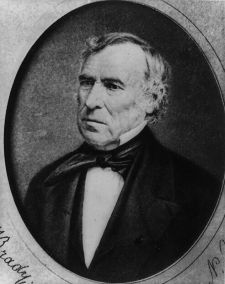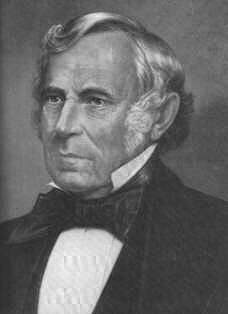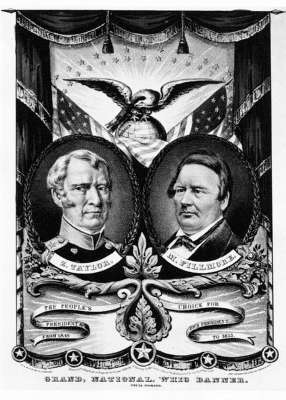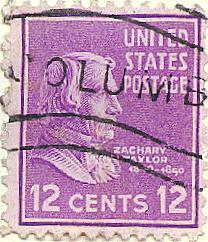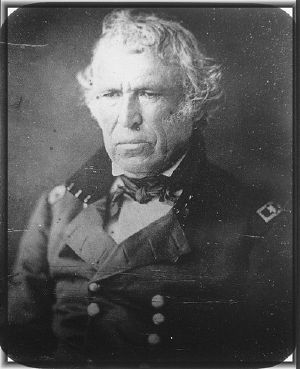Encyclopedia, Difference between revisions of "Zachary Taylor" - New World
Laura Brooks (talk | contribs) |
Laura Brooks (talk | contribs) |
||
| Line 26: | Line 26: | ||
==Early life and family== | ==Early life and family== | ||
| − | Taylor was born on November 24, 1784 | + | Zachary Taylor was born in Orange County, [[Virginia]] on November 24, 1784. He was the third of nine children of Richard and Sarah Strother Taylor. His parents both came from affluent families. His father was an army officer who had served with [[George Washington]] in the [[American Revolution]]. When Zachary was only a few months old his family moved to a plantation in [[Kentucky]] There was little opportunity for a formal education in that area, Zachary was educated by private tutors. |
| − | Zachary | + | Zachary always dreamed of being in the military. His father often entained the [[family]] with stories of his military service in the days of the [[American Revolution]]. Zachary maintained his love of farming even though his career was in the military. |
| − | Taylor | + | Taylor married Margaret Mackall Smith, the daughter of a Continental Army major, in 1810. The Taylors had six children, four of whom survived to adulthood. During her husband's long army career, Mrs. Taylor followed him from on frontier post to another. As First Lady, she rarely made public appearances. |
| − | |||
| − | |||
| − | |||
| − | |||
| − | |||
| − | |||
==Military career== | ==Military career== | ||
[[Image:Zachary Taylor.jpg|right|thumb|Zachary Taylor]] | [[Image:Zachary Taylor.jpg|right|thumb|Zachary Taylor]] | ||
| − | + | In 1808, with the help of family friend [[James Madison]], Taylor was commissioned a lieutenant in the U.S. Army; two years later he achieved the rank of captain. During the [[War of 1812]] he served with distinction in the defense of Fort Harrison against [[Tecumseh]]'s forces in the Indiana Territory. | |
| − | |||
| − | During the [[War of 1812]] | ||
| − | + | During the [[War of 1812]], Taylor became known as a talented military commander. Assigned to command Fort Harrison on the Wabash River, at the northern edge of Terre Haute, Indiana, he successfully commandeered a small force of soldiers and civilians to stave off an British-inspired attack by about 500 Native Americans between September 4 and September 15. The Battle of Fort Harrison, as it became known, has been referred to as the "first American land victory of the War of 1812." Taylor received a brevet promotion to major on October 31, 1812. Taylor was promoted to lieutenant colonel on April 20, 1819, and colonel on April 5, 1832. | |
| − | + | Taylor served in the Black Hawk War and the Second Seminole War . During the Seminole War, Taylor fought at the Battle of Lake Okeechobee and received a brevet promotion to brigadier general]] in January 1838. It was here he gained his nickname "Old Rough and Ready" for his rumpled clothes and wide-brimmed straw hat. On May 15, 1838, Taylor was promoted commanding general of all U.S. forces in Florida. | |
| − | Polk | + | [[James K. Polk]] sent the Army of Occupation under Taylor's command to the Rio Grande in 1846. [[Mexico]] attacked Taylor's troops and Taylor defeated them despite being outnumbered 4-to-1. Polk later declared war. |
| + | The Mexican War transformed Taylor from a minor military figure into a presidential contender. He was dispatched to the disputed Texas border and won twin victories at Palo Alto and Resaca de la Palma in May 1846, several days before war was declared by Congress. Following the declaration, he invaded [[Mexico]] and took Matamoras and Monterrey. Taylor, however, became the object of criticism because of his alleged failure to press on following his initial success. Many later historians recognized that his caution was rooted in his lack of supplies, trained recruits and dependable transportation. President Polk, unhappy with the stalled progress, diverted a portion of Taylor’s army to Winfield Scott, who was assigned the task of taking Mexico City. Despite his reduced force, Taylor defeated General Antonio López de Santa Anna at the Battle of Buena Vista in February 1847, and immediately became a national hero. | ||
==Election of 1848== | ==Election of 1848== | ||
Revision as of 16:53, 11 August 2006
| Term of office | March 4, 1849 – July 9, 1850 |
| Preceded by | James K. Polk |
| Succeeded by | Millard Fillmore |
| Date of birth | November 24, 1784 |
| Place of birth | Barboursville, Virginia |
| Date of death | July 9, 1850 |
| Place of death | Washington, D.C. |
| Spouse | Margaret Smith Taylor |
| Political party | Whig |
Zachary Taylor (November 24, 1784–July 9, 1850) was an American military leader and the twelfth President of the United States. Taylor had a 40-year military career in the United States Army, serving in the War of 1812, Black Hawk War, and Second Seminole War before achieving fame while leading U.S. troops to victory at several critical battles of the Mexican-American War. A Southern slaveholder who opposed the spread of slavery to the territories, he was uninterested in politics but was recruited by the Whig Party as their nominee in the 1848 presidential election. In the election Taylor defeated the Democratic nominee, Lewis Cass, and became the first U.S. president to never hold any prior office. Taylor died of acute gastroenteritis just 16 months into his term. Vice President Millard Fillmore became President.
Early life and family
Zachary Taylor was born in Orange County, Virginia on November 24, 1784. He was the third of nine children of Richard and Sarah Strother Taylor. His parents both came from affluent families. His father was an army officer who had served with George Washington in the American Revolution. When Zachary was only a few months old his family moved to a plantation in Kentucky There was little opportunity for a formal education in that area, Zachary was educated by private tutors.
Zachary always dreamed of being in the military. His father often entained the family with stories of his military service in the days of the American Revolution. Zachary maintained his love of farming even though his career was in the military.
Taylor married Margaret Mackall Smith, the daughter of a Continental Army major, in 1810. The Taylors had six children, four of whom survived to adulthood. During her husband's long army career, Mrs. Taylor followed him from on frontier post to another. As First Lady, she rarely made public appearances.
Military career
In 1808, with the help of family friend James Madison, Taylor was commissioned a lieutenant in the U.S. Army; two years later he achieved the rank of captain. During the War of 1812 he served with distinction in the defense of Fort Harrison against Tecumseh's forces in the Indiana Territory.
During the War of 1812, Taylor became known as a talented military commander. Assigned to command Fort Harrison on the Wabash River, at the northern edge of Terre Haute, Indiana, he successfully commandeered a small force of soldiers and civilians to stave off an British-inspired attack by about 500 Native Americans between September 4 and September 15. The Battle of Fort Harrison, as it became known, has been referred to as the "first American land victory of the War of 1812." Taylor received a brevet promotion to major on October 31, 1812. Taylor was promoted to lieutenant colonel on April 20, 1819, and colonel on April 5, 1832.
Taylor served in the Black Hawk War and the Second Seminole War . During the Seminole War, Taylor fought at the Battle of Lake Okeechobee and received a brevet promotion to brigadier general]] in January 1838. It was here he gained his nickname "Old Rough and Ready" for his rumpled clothes and wide-brimmed straw hat. On May 15, 1838, Taylor was promoted commanding general of all U.S. forces in Florida.
James K. Polk sent the Army of Occupation under Taylor's command to the Rio Grande in 1846. Mexico attacked Taylor's troops and Taylor defeated them despite being outnumbered 4-to-1. Polk later declared war. The Mexican War transformed Taylor from a minor military figure into a presidential contender. He was dispatched to the disputed Texas border and won twin victories at Palo Alto and Resaca de la Palma in May 1846, several days before war was declared by Congress. Following the declaration, he invaded Mexico and took Matamoras and Monterrey. Taylor, however, became the object of criticism because of his alleged failure to press on following his initial success. Many later historians recognized that his caution was rooted in his lack of supplies, trained recruits and dependable transportation. President Polk, unhappy with the stalled progress, diverted a portion of Taylor’s army to Winfield Scott, who was assigned the task of taking Mexico City. Despite his reduced force, Taylor defeated General Antonio López de Santa Anna at the Battle of Buena Vista in February 1847, and immediately became a national hero.
Election of 1848
He received the Whig nomination for President in 1848 although he had never even bothered to vote before. In fact, he had never even bothered to register and did not vote in his own election. [citation needed] His homespun ways were political assets; his long military record appealed to northerners; and his ownership of slaves would attract southern votes. He also had not previously committed himself on troublesome issues. He ran against the Democratic candidate, Lewis Cass, who favored letting the residents of territories decide for themselves whether they wanted slavery. In protest against Taylor, a slaveholder, and Cass, an advocate of "squatter sovereignty," northerners who opposed extension of slavery into territories formed the Free Soil Party and nominated Martin Van Buren. In a close election, the Free Soilers pulled enough votes away from Cass to elect Taylor.
To the astonishment of Whigs, Taylor virtually repudiated their platform, As historian Michael Holt explains:
Taylor was equally indifferent to programs Whigs had long considered vital. Publicly, he was artfully ambiguous, refusing to answer queries about his views on banking, the tariff, and internal improvements. Privately, he was more forthright. The idea of a national bank "is dead, & will not be revived in my time." In the future the tariff "will be increased only for revenue"; in other words, Whig hopes of restoring the protective tariff of 1842 were vain. There would never again be surplus federal funds from public land sales to distribute to the states, and internal improvements "will go on in spite of presidential vetoes." In a few words, that is, Taylor pronounced an epitaph for the entire Whig economic program.[1]
Presidency
Policies
Although Taylor had subscribed to Whig principles of legislative leadership, he was not inclined to be a puppet of Whig leaders in Congress. He acted at times as though he were above parties and politics. As disheveled as always, Taylor tried to run his administration in the same rule-of-thumb fashion with which he had fought Indians.
Under Taylor´s administration the United States Department of the Interior was organized, although the department had been activated under President Polk´s last day in office.
Compromise of 1850
The slavery issue dominated Taylor's short term. Although he owned slaves, he took a moderately anti-slavery position. Taylor urged settlers in New Mexico and California to draft constitutions and apply for statehood, bypassing the territorial stage. New Mexico was too small to act but California—which had high population growth from the gold rush—wrote a constitution that did not allow slavery; it was approved by the voters and a new state government took over in December 1849 without Congressional approval. Southerners were furious with Taylor (a southerner) and with California. In February 1850, Taylor held a stormy conference with southern leaders who threatened secession. He told them that if necessary to enforce the laws, he personally would lead the Army. Persons "taken in rebellion against the Union, he would hang ... with less reluctance than he had hanged deserters and spies in Mexico." He never wavered. Henry Clay then proposed a complex Compromise of 1850. Taylor died as it was being debated. (The Clay version failed but another version did pass under the new president, Millard Fillmore.)
Administration and Cabinet
| OFFICE | NAME | TERM |
| President | Zachary Taylor | 1849–1850 |
| Vice President | Millard Fillmore | 1849–1850 |
| Secretary of State | John M. Clayton | 1849–1850 |
| Secretary of the Treasury | William Meredith | 1849–1850 |
| Secretary of War | George Crawford | 1849–1850 |
| Attorney General | Reverdy Johnson | 1849–1850 |
| Postmaster General | Jacob Collamer | 1849–1850 |
| Secretary of the Navy | William Preston | 1849–1850 |
| [Secretary of the Interior | Thomas Ewing | 1849–1850 |
Supreme Court appointments
none
States admitted to the Union
none
Death
The cause of Zachary Taylor's death is not well understood, nor is it well documented. On July 4, 1850, Taylor was diagnosed by his physicians with cholera morbus, a term that included diarrhea and dysentery but not true cholera. Cholera, typhoid fever, and food poisoning have all been indicated as the source of the president's gastroenteritis. More specifically, a hasty snack of cold milk and cherries might have been the culprit. By July 9, Taylor was dead.
In 1991, Taylor's body was exhumed, and Larry Robinson and Frank Dyer conducted an autopsy at the Oak Ridge National Laboratory. Investigating the possibility of assassination by means of deliberate poisoning, Dyer and Robinson detected traces of arsenic and sent the results to a Kentucky medical examiner, who determined the quantity was insufficient to have been fatal.[1] In an effort to undermine these findings and promote the possibility of assassination, Michael Parenti devoted a chapter in his controversial 1999 book History as Mystery to what he called "The Strange Death of Zachary Taylor." In it he notes that Robinson and Dyer analyzed a single hair in its entirety, when they should have only analyzed a cross-section near the scalp — the only relevant portion.[2] Given this error, the actual quantity of arsenic in Taylor's system at the time of his death remains unknown, and assassination can neither be confirmed nor decisively ruled out.[3]
Taylor was succeeded by Vice President Millard Fillmore. He is buried in Louisville, Kentucky, at what is now the Zachary Taylor National Cemetery.
Surviving family
Taylor's son Richard Taylor became a Confederate Lieutenant General, while his daughter Sarah Knox Taylor (1814–1835) had married future President of the Confederate States Jefferson Davis three months before her death of malaria. Taylor's brother, Joseph Pannill Taylor, was a Brigadier General in the Grand Army of the Republic during the Civil War. Taylor's niece Emily Ellison Taylor was the wife of Confederate General Lafayette McLaws.
Trivia
- Taylor's term of service was scheduled to begin on March 4, 1849, but as this day fell on a Sunday, Taylor refused to be sworn in until the following day. Vice President Millard Fillmore was also not sworn in on that day. As a result, it is often claimed that the previous president pro tempore of the Senate, David Rice Atchison, was "president for a day," or that the presidency was vacant. Most scholars believe that according the United States Constitution, Taylor's term began on March 4, regardless of whether he had taken the oath or not.
- It is believed that Taylor sometimes needed to be boosted into his saddle, since he stood 5 feet 8 inches or 5 feet 9 inches (172-175 cm) tall. He weighed between 170 and 200 pounds (80-90 kg).
- Taylor always preferred old and slovenly clothes (including his unique straw hat) to military uniforms, leading to his nickname, "Old Rough and Ready."
- In 1942, a Liberty ship named the SS Zachary Taylor was launched. The ship was scrapped in 1961.
- Taylor had a stutter.
- Taylor was a poor writer and had difficulty spelling.
ReferencesISBN links support NWE through referral fees
- Bauer, Jack K. Zachary Taylor: Soldier, Planter, Statesman of the Old Southwest Newtown, CT : American Political Biography Press, 1994 ISBN 0945707088
- Hamilton, Holman Zachary Taylor: Soldier of the Republic 2 vol., Norwalk, Conn. : Easton Press, c1989 "Soldier of the Republic", " Soldier in the White House"
- Michael F. Holt The Rise and Fall of the American Whig Party: Jacksonian Politics and the Onset of the Civil War. New York : Oxford University Press, 1999 ISBN 0195055446
- Smith, Elbert B. The Presidencies of Zachary Taylor and Millard Fillmore Lawrence, Kan.: University Press of Kansas, 1988 ISBN 070060362X.
External links
- White House Biography
- Zachary Taylor State of the Union Address
- Inaugural Address of Zachary Taylor
- Medical and Health history of Zachary Taylor
- Works by Zachary Taylor. Project Gutenberg
- Photo of grave of President Zachary Taylor, with GPS coordinates
| Preceded by: Henry Clay |
Whig Party presidential nominee 1848 (won) |
Succeeded by: Winfield Scott |
| Preceded by: James K. Polk |
President of the United States March 4, 1849 – July 9, 1850 |
Succeeded by: Millard Fillmore |
Credits
New World Encyclopedia writers and editors rewrote and completed the Wikipedia article in accordance with New World Encyclopedia standards. This article abides by terms of the Creative Commons CC-by-sa 3.0 License (CC-by-sa), which may be used and disseminated with proper attribution. Credit is due under the terms of this license that can reference both the New World Encyclopedia contributors and the selfless volunteer contributors of the Wikimedia Foundation. To cite this article click here for a list of acceptable citing formats.The history of earlier contributions by wikipedians is accessible to researchers here:
The history of this article since it was imported to New World Encyclopedia:
Note: Some restrictions may apply to use of individual images which are separately licensed.
- ↑ [Holt 1999 p 272]
